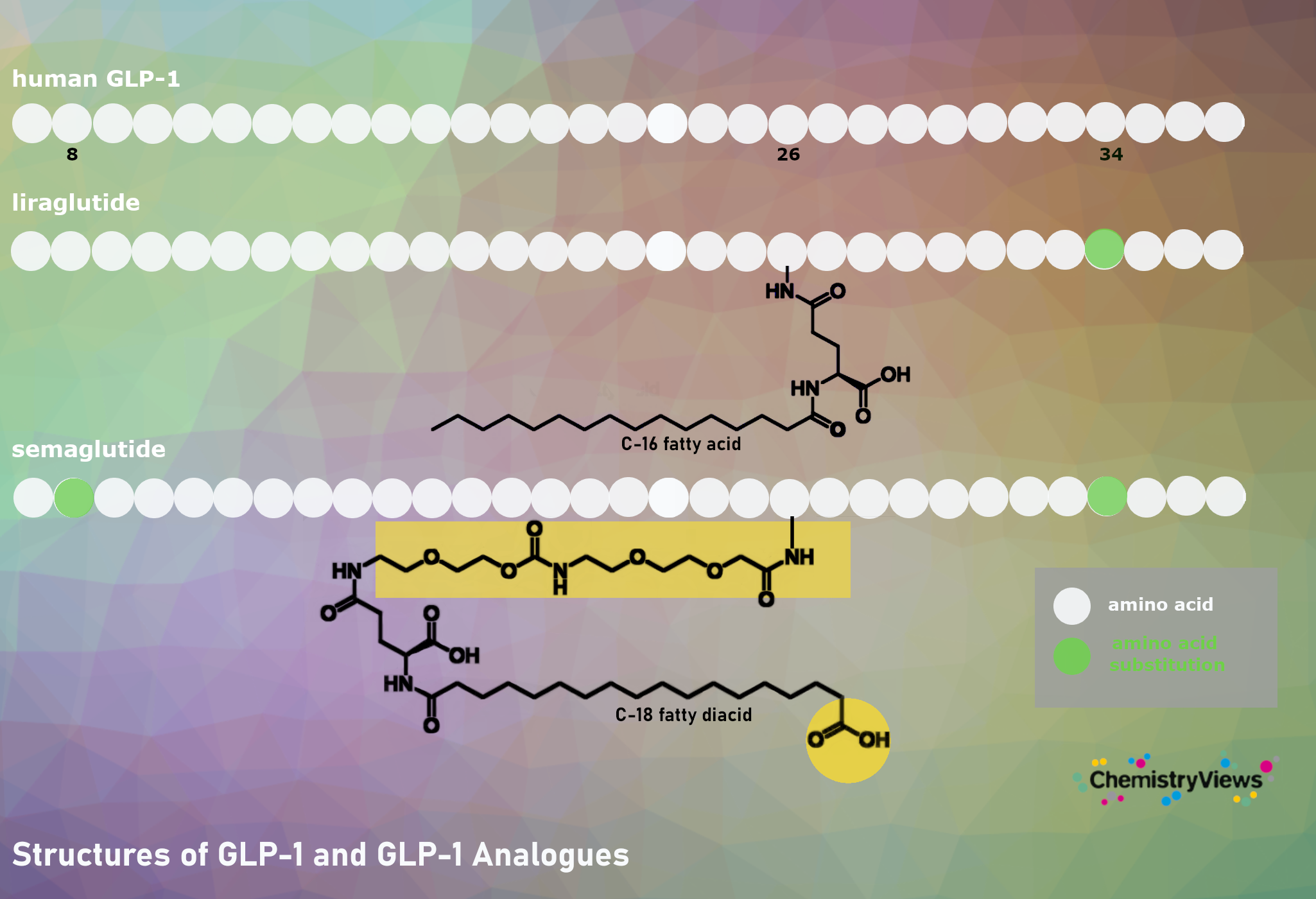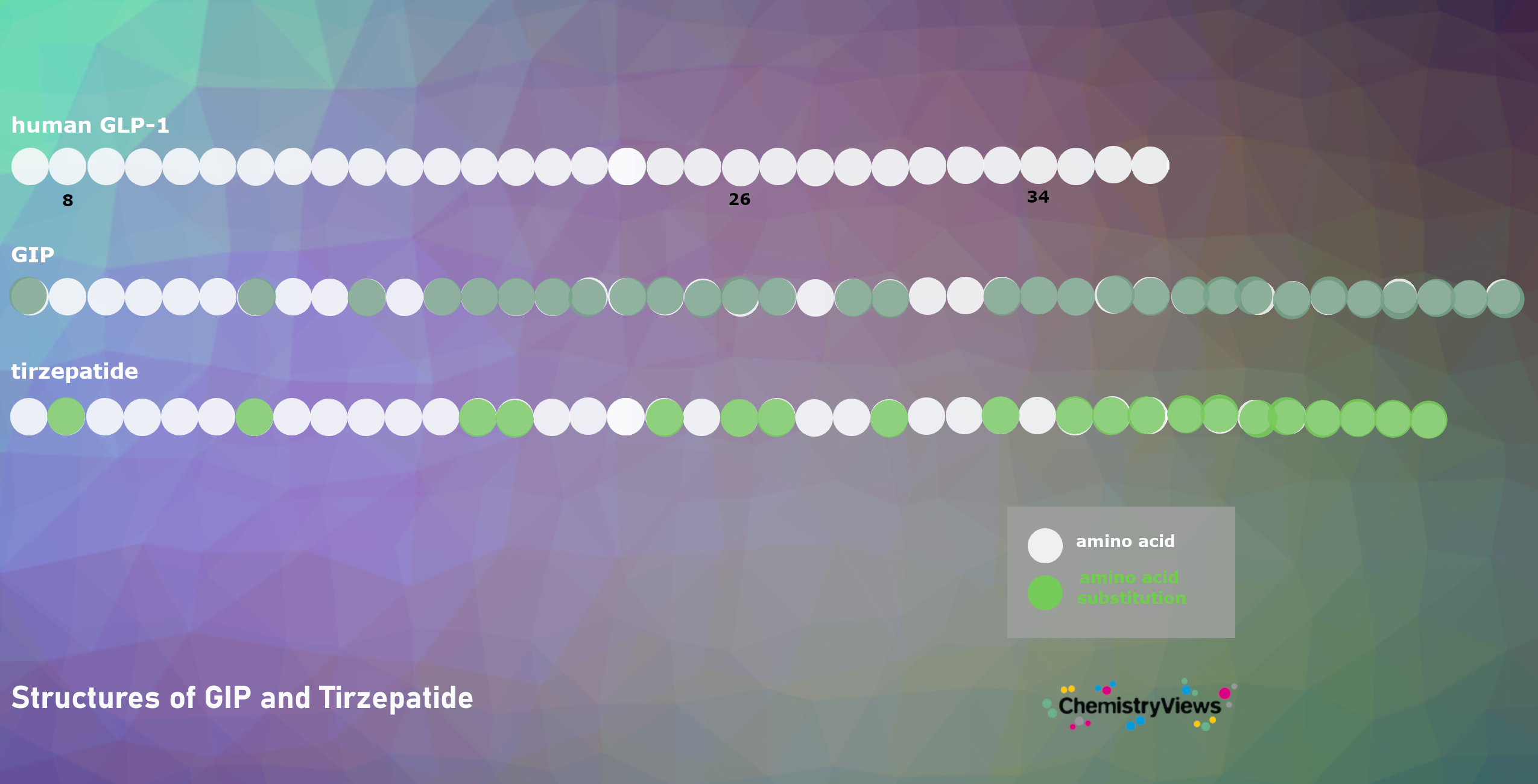It’s the time of year when some people’s thoughts turn to the excesses of the festive period and how to counteract them. In previous years we might have considered joining a gym or experimenting with a new diet, but now the weight-loss industry has a new string to its bow: diabetes treatments repurposed as weight-loss drugs.
2024 saw a growing number of famous faces turning to the jabs, known by their brand names Ozempic/Wegovy (semaglutide) and Saxenda (liraglutide) among others, and there is now an increasing public awareness of the drugs. It’s a good time to take another look: how they work, how they are made, how safe they are, and whether they really could be a panacea for the “obesity epidemic”.

Figure 1. Schematic structure of human GLP-1, liraglutide (sold under the brand name Victoza for diabetes treatment and Saxenda for weight loss by Novo Nordisk), and semaglutide (sold, e.g., as Ozempic for diabetes treatment and Wegovy for weight loss by Novo Nordisk).
What to Know About Weight-Loss Injections?
These drugs are synthetic versions of a protein produced naturally in our bodies which has an important role in our metabolism and regulating blood sugar. In this article, the overarching term “glucagon-like peptide 1 receptor agonists” (GLP-1RA) will be used to cover the various molecules used in different weight-loss drugs available. These molecules work by activating the GLP-1 receptor, a protein involved in regulating blood sugar levels and appetite.
 Figure 2. GLP-1R apo structure. N-terminus colored blue, C-terminus colored red. Based on PDB 7RG9 (cryo-EM of human Glucagon-like peptide 1 receptor GLP-1R in apo form). (graphic by Scheng23 CC BY-SA 4.0)
Figure 2. GLP-1R apo structure. N-terminus colored blue, C-terminus colored red. Based on PDB 7RG9 (cryo-EM of human Glucagon-like peptide 1 receptor GLP-1R in apo form). (graphic by Scheng23 CC BY-SA 4.0)
Arguably the most well-known name among these is Ozempic, which is actually only licensed by Novo Nordisk for managing blood sugar levels in type 2 diabetes. Its weight loss counterpart is Wegovy, manufactured by the same company, which can be supplied in higher doses than Ozempic.
Let’s look first at how things should work when we’re healthy.
Healthy Metabolism
In healthy individuals, a number of feedback loops are involved in regulating blood glucose, appetite, and feelings of fullness or satiety. In the event of low blood sugar, the peptide hormone glucagon is released from α-cells in the pancreas and travels to the liver and muscles, where it causes cells to convert their stored glycogen to glucose, raising the blood glucose level.
Conversely, in the event of high blood sugar, glucose has to be removed from the bloodstream and stored. To do this, β-cells in the pancreas are stimulated, by naturally occurring glucagon-like peptide 1 (GLP-1), to produce and release insulin. Insulin travels to cells all over our body and sends a signal to encourage these cells to absorb glucose and use it or convert it to glycogen for storage.
GLP-1 is a peptide hormone made up of 30 amino acids, which binds to a G-protein coupled receptor on the surface of cells in the pancreas and brain, causing a change in the shape of this receptor which transduces signals inside the cell, promoting the production of the peptide hormone insulin. GLP-1 is quickly broken down in the body by the enzyme dipeptidyl peptidase 4 (DPP-IV), which splits it into smaller fragments so it can no longer have an effect.

Figure 3. Enzyme dipeptidyl peptidase 4 (DPP-IV).
In type 2 diabetes—the condition GLP-1 receptor agonists were initially developed to treat—the cells of the body have become resistant to insulin and the β-cells of the pancreas no longer produce as much insulin as they should. This leads to a dysregulated system for controlling blood glucose levels and also means that cells which need glucose, in other words virtually all the cells in our body, cannot absorb enough of it. Untreated type 2 diabetes can result in heart disease, stroke, nerve damage, blindness, and circulatory issues which might even culminate in limb amputation.
What are GLP-1 Receptor Agonists? How Are They Made?
Semaglutide, the active peptide in Wegovy/Ozempic, is a glucagon-like peptide 1 mimetic, or glucagon-like peptide 1 receptor agonist (GLP-1RA). This means it acts in the same way as natural GLP-1, binding to the same cell surface receptors. It was developed by the Danish pharmaceutical company Novo Nordisk, and has been so successful and sought-after that it has made Novo Nordisk the most valuable company in Europe for the last two years running.
Novo Nordisk’s breakthrough was attaching a hydrophobic fatty acid chain to a synthetic version of GLP-1, allowing the molecule to bind to albumin in our bloodstream, which makes it much bulkier and more resistant and stops DPP-IV from breaking it down. Thanks to this modification, semaglutide remains in the bloodstream for around a week, reducing the need for frequent injections.
Semaglutide is actually synthesized using recombinant yeast genetically engineered to secrete a precursor compound which is then modified in subsequent synthesis steps, ultimately giving semaglutide.
Other companies producing rival GLP-1RAs have made use of different techniques. For example, Eli Lilly’s compound, tirzepatide, which targets the GLP-1 receptor and another related receptor (GIP), is produced by a more conventional, but ultimately convoluted, chemical synthesis. An initial section of peptide is attached to a bead, and then other amino acid residues are added one-by-one to create a long peptide chain. At each stage, the residues are blocked off with protecting groups to avoid cross-reactions.

Figure 4. Schematic structure of GIP and tirzepatide (Mounjaro for diabetes treatment and Zepbound for weight loss by Eli Lilly).
The Good
GLP-1RAs mimic GLP-1 and therefore bind to the same receptors, stimulating insulin production and lowering blood sugar levels.
Semaglutide and other GLP-1RAs have also been found to slow stomach emptying, creating a persistent feeling of fullness. They are also purported to act on the areas of the brain which control appetite, though the mechanism behind this is still something of a mystery, since the bulky molecules are too large to cross the blood-brain barrier. Overall, they cause people to feel fuller for longer, reduce their desire for food, and help their cells take in and use glucose.
Of course, the majority of the public is aware of GLP-1RAs because of weight loss, a beneficial side effect discovered in initial trials on type 2 diabetes [1]. Average weight loss reported in a trial, published in the New England Journal of Medicine, was nearly 15% in the group that received semaglutide, compared to 2.5% in the placebo group. Participants in this and other trials have reported a loss of appetite and a reduced desire to consume food.
It is worth noting that this study, and a number of other articles published since [2], was partially funded by Novo Nordisk or other rival manufacturers, but the difference in results between semaglutide recipients and placebo has still made a huge impact around the world.
Various other positive effects aside from weight loss have come to light as more people are taking GLP-1RAs: there have been reports of favorable impacts on addiction, Huntington’s disease, Alzheimer’s, depression, anxiety, and cardiovascular conditions [4–7]. GLP-1RAs also help to reduce inflammation, opening up a potential glut of additional applications in treating inflammation-related diseases.
The Bad
Now that the world at large is more aware of GLP-1RAs, there is an ever-growing risk of counterfeit drugs [8] as demand exceeds supply and pharma companies try to cash in on their popularity.
Aside from the risk of taking something which isn’t actually a GLP-1RA, there is a host of unwelcome side effects [9] to contend with. Some of the most commonly reported side effects of semaglutide are unsurprising when we consider its appetite-suppressing mechanism of action: nausea, vomiting, diarrhea, and general gastrointestinal discomfort.
However, there are some other, more worrying side effects such as an increased risk of thyroid tumors, kidney problems, and pancreatitis. The official Ozempic website even contains a warning that anyone undergoing surgery or sedation should cease their injections and inform their doctor, as there is a risk of choking on food which has stayed in the stomach while sedated; even after fasting the day before. It is clear that GLP-1RAs are having an impact outside the biological system they were designed to treat.
A number of experts have also expressed concern that semaglutide and other GLP-1RAs will be used as a “quick fix” for the “obesity epidemic” facing a number of Western countries [10]. They argue that since obesity is actually a chronic condition rather than something which can be fixed by a course of treatment, a more sensible approach would be to focus on the causes of obesity and prevention, pushing for changes to government policy [11] and promoting lifestyle improvements in terms of diet and exercise.
And so far all the positive news seems to be rather short-sighted: what about longer-term effects?
Semaglutide is only approved for use for two years, after which time studies show that the majority of subjects regain virtually all the weight they have lost [12]. If that time was spent focusing on lifestyle changes, improving access to more nutritionally balanced food, and addressing other causes of obesity such as stress and work-life balance, experts argue, people could have sustainable practices in place which would last long after the injections stop.
The Future
The global trend of weight-loss injections shows no signs of subsiding. Novo Nordisk is scaling up production and quality control massively over the next few years, as well as buying up other companies with the capacity to produce GLP-1RAs for them [13]. And other companies are looking at longer-term goals: Eli Lilly has just signed a deal with Manchester University, UK, to look more closely at the effects of another GLP-1RA, tirzepatide, over five years [14].
While 2025 is set to be another huge year for GLP-1RAs, it is vital that the public is more aware of the issues at stake in using them, and that they are not a cure-all. Encouraging lifestyle interventions is not only less expensive than developing weight loss drugs, it leads to much more sustainable results without interfering with complex and intertwined biological systems. Perhaps reaching for the gym membership rather than the injection pen will make for a happier year ahead, after all.
References and Sources
[1] John P. H. Wilding, Rachel L. Batterham, Salvatore Calanna, Melanie Davies, Luc F. Van Gaal, Ildiko Lingvay, arbara M. McGowan, Julio Rosenstock, Marie T. D. Tran, Thomas A. Wadden, Sean Wharton, Koutaro Yokote, Niels Zeuthen, Robert F. Kushner, Once-Weekly Semaglutide in Adults with Overweight or Obesity, N. Engl. J. Med. 2021, 384, 989–1002. https://doi.org/10.1056/NEJMoa2032183
[2] Donna H. Ryan, Ildiko Lingvay, John Deanfield, Steven E. Kahn, Eric Barros, Bartolome Burguera, Helen M. Colhoun, Cintia Cercato, Dror Dicker, Deborah B. Horn, G. Kees Hovingh, Ole Kleist Jeppesen, Alexander Kokkinos, A. Michael Lincoff, Sebastian M. Meyhöfer, Tugce Kalayci Oral, Jorge Plutzky, André P. van Beek, John P. H. Wilding, Robert F. Kushner, Long-term weight loss effects of semaglutide in obesity without diabetes in the SELECT trial, Nature Medicine 2024, 30, 2049–2057. https://doi.org/10.1038/s41591-024-02996-7
[3] Nora D. Volkow, Rong Xu, GLP-1R agonist medications for addiction treatment, Addiction 2024. https://doi.org/10.1111/add.16626
[4] Bronwen Martin, Erin Golden, Olga D. Carlson, Paul Pistell, Jie Zhou, Wook Kim, Brittany P. Frank, Sam Thomas, Wayne A Chadwick, Nigel H. Greig, Gillian P. Bates, Kirupa Sathasivam, Michel Bernier, Stuart Maudsley, Mark P. Mattson, Josephine M. Egan, Exendin-4 improves glycemic control, ameliorates brain and pancreatic pathologies, and extends survival in a mouse model of Huntington’s disease, Diabetes 2009, 58(2), 318–28. https://doi.org/10.2337/db08-0799
[5] Igor Henrique Rodrigues de Paiva, Rodrigo Soares da Silva, Ingrid Prata Mendonça, José Roberto Botelho de Souza, Christina Alves Peixoto, Semaglutide Attenuates Anxious and Depressive-Like Behaviors and Reverses the Cognitive Impairment in a Type 2 Diabetes Mellitus Mouse Model Via the Microbiota-Gut-Brain Axis, J. Neuroimmune Pharmacol. 2024, 19(1), 36. https://doi.org/10.1007/s11481-024-10142-w
[6] Novo Nordisk A/S (Responsible Party), Semaglutide Effects on Heart Disease and Stroke in Patients With Overweight or Obesity (SELECT), ClinocalTrials.gov NCT03574597, 2024-08-30. (accessed December 18, 2024)
[8] Committee for Medicinal Products for Human Use (CHMP), Assessment report: Ozempic, International non-proprietary name: semaglutide, Procedure No. EMEA/H/C/004174/0000, EMA/CHMP/715701/2017, European Medicines Agency (EMA), London UK, 14 December 2017.
[9] Ozempic Website by Novo Nordisk: Common side effects, There are possible side effects when taking Ozempic®. (accessed December 2024)
[10] Weight loss jabs not ‘quick fix’ for UK worklessness, health experts warn, The Guardian Nov. 2024. (accessed December 18, 2024)
[11] Weight-loss jabs shouldn’t be quick-fix solution for governments, says expert, The Guardian June 2024. (accessed December 18, 2024)
[12] John P. H. Wilding, Rachel L. Batterham, Melanie Davies, Luc F. Van Gaal, Kristian Kandler, Katerina Konakli, Ildiko Lingvay, Barbara M. McGowan, Tugce Kalayci Oral, Julio Rosenstock, Thomas A Wadden, Sean Wharton, Koutaro Yokote, Robert F. Kushner, Weight regain and cardiometabolic effects after withdrawal of semaglutide: The STEP 1 trial extension, Diabetes Obes. Metab. 2022, 24(8), 1553–1564. https://doi.org/10.1111/dom.14725
[13] Fraiser Kansteiner, Novo Nordisk keeps manufacturing expansion spree rolling with plans for $400M quality hub in Denmark, FiercePharma Dec 4, 2024. (accessed December 18, 2024)
[14] New study to deepen understanding of a weight loss medication, Manchester University, UK, 14 October 2024. (accessed December 18, 2024)
Also of Interest

Spotlight: Who Was the First to Synthesize Insulin?
Insulin is a peptide hormone consisting of two chains connected by disulfide bonds. It is a polypeptide hormone produced by the β-cells of the pancreas, responsible for regulating blood sugar levels.





